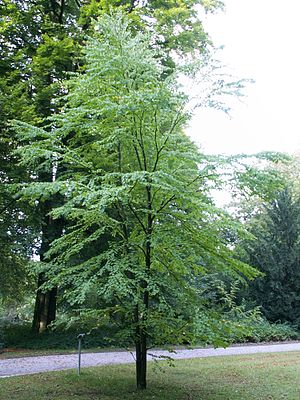Japanese cake tree
| Japanese cake tree | ||||||||||||
|---|---|---|---|---|---|---|---|---|---|---|---|---|

Japanese cake tree ( Cercidiphyllum japonicum ) |
||||||||||||
| Systematics | ||||||||||||
|
||||||||||||
| Scientific name | ||||||||||||
| Cercidiphyllum japonicum | ||||||||||||
| Siebold & Zucc. ex JJHoffm. & JHSchult.bis |

The katsura tree ( Cercidiphyllum japonicum ) or Japanese. 桂 , Katsura , also Japanese Katsura , gingerbread tree or simple, but not unique, cupcake tree called, one is tree art from the only two species counted genus cake trees ( Cercidiphyllum ).
Surname
The name cake tree comes from the smell of the leaves before and after they fall in autumn. Especially in damp weather, the leaves smell of fresh pastries, caramel or gingerbread . However, the smell disappears as the leaves dry.
description
Vegetative characteristics
The Japanese cake tree is a deciduous deciduous tree or large shrub that can grow to heights of 10 to 20, rarely 30, meters and has an elongated, cone-shaped, often quite light crown of steeply rising branches. The bark is brown-gray and smooth on young trees. Later it becomes rough or finely fielded. The roots are flat to heart-shaped and do not form runners. The tree is very long-lived.
The dimorphic leaves emerge early in the year. They are arranged opposite one another on long shoots . In addition to these long shoots, there are also short shoots that, among other things, grow directly from the trunk. There are somewhat narrower leaves on these, which are always there individually. The leaf stalks are up to six inches long and mostly dark red. The different blades are almost at right angles to the petiole and on the long shoots are broadly ovate to elliptical, hand-nerved and entire to finely sawed or on short shoots heart- to kidney-shaped and notched. The leaves are bare and have a dull green color on the top and pale green-bluish on the underside. The underside of the leaf can also be hairy. They quickly change color to salmon pink and later to golden yellow. Shortly before the leaves fall, they smell of cotton candy and freshly baked cake, from which the common name is derived. The leaves each have stipules.
Generative characteristics
The trees are mostly dioecious and separate sexes. The inconspicuous reddish " flowers " appear in March or April before the leaves and bloom until May. The flowers without flower covers are here in dense inflorescences, which represent the "flowers" here, at the end of the short shoots in the common leaf nodes . The male flower has up to 13, up to 10 millimeters long, stamens with long stamens and reddish anthers. Several male flowers stand together in the male inflorescence with bracts . The female flowers consist only of a short-stalked carpel with many ovules with a long, flat and red stigma . They stand together up to eight in the short-stalked female inflorescences with bracts.
The small follicle fruit has a brownish color and is slightly sickle-shaped with a small beak and it contains many flat, brown, up to 5 millimeters long, trapezoidal, winged seeds. The fruits stay there over the winter.
The number of chromosomes is 2n = 38.
distribution
The Japanese cake tree comes from East Asia , especially Japan and China . Natural areas are located next to Japan in the Chinese provinces: southern and western Anhui , southern Gansu , northeastern Guizhou , southwestern Henan , Hubei , northwestern Hunan , northern Jiangxi , southern Shaanxi , southwestern Shanxi , Sichuan , northeastern Yunnan and northwestern Zhejiang . It grows in forests, on the edges of forests and along rivers at altitudes between 600 and 2700 meters.
In the temperate latitudes , it is planted as a rare decorative ornamental wood in gardens and parks, but hardly gets higher than twelve meters. It grows in light bushes and prefers loose, humus and nutrient-rich soil as well as a sunny or partially shaded location. It is sensitive to drought.
Ornamental shapes
There are the ornamental forms Cercidiphyllum japonicum f. pendulum and Cercidiphyllum japonicum f. miquelianum and the varieties 'Rotfuchs', 'Heronswood Glo', 'Peach', 'Raspberry', 'Ruby', 'Strawberry' and 'Tidal Wave'.
photos
literature
- Bruno P. Kremer: Steinbach's great plant guide. Ulmer, Stuttgart 2005, ISBN 3-8001-4903-6 .
Web links
Individual evidence
- ^ Klaus Kubitzki , Jens G. Rohwer , Volker Bittrich: The Families and Genera of Vascular Plants. Vol. II, Springer, 1993, ISBN 978-3-64208141-5 (reprint), p. 250 ff.
- ↑ Cercidiphyllum japonicum at Tropicos.org. In: IPCN Chromosome Reports . Missouri Botanical Garden, St. Louis.



